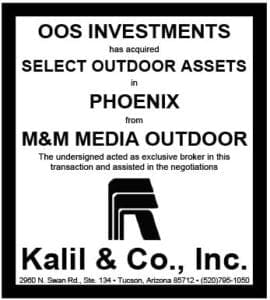
The International Right of Way Association had an educational session on billboard appraisal methodologies and case law on June 14, 2016, as part of its 62nd International Conference. The presenters were J. Allen Smith of the SettlePou law firm who is chair of OAAA’s billboard valuation subcommittee, and Paul Wright of SignValue, a longstanding OAAA member who has provided valuation services to industry as well as government agencies. You can download the Smith and Wright presentations at the OAAA website. We have attached an article which Wright and Smith prepared on their talk.
Billboard valuation issues are still a priority concern with state and local agencies. The transportation re-authorization bill, signed by President Obama on December 5, 2015, increases federal and state funding to widen existing highways.
Thus, a direct impact to the OOH Media industry could be an increase in the number of billboards which may have to be acquired and removed; or, potentially relocated to a nearby site.
So, the invitation to educate government as well as private sector appraisers and right of way officials comes at an opportune time for the industry.
The OOH media is impacted by stringent rules at all three levels of government and a quick primer on valuation and compensation reveals that the industry is also directly affected by government’s extraordinary power to acquire private property for public purposes (i.e., eminent domain). Nichols on Eminent Domain, Chapter 23, includes a comprehensive analysis of billboards, eminent domain and valuation concerns.
However, it is very clear that when government condemns billboards, it must compensate the owner of both the billboard and the property on which it is located. The fundamental law pertaining to billboard valuation is the Fifth Amendment to the U.S. Constitution: “nor shall private property be taken for public use, without just compensation.”
The Highway Beautification Act of 1965, as amended, along with numerous state statutes upholds this important, and mandatory, protection for the OOH media industry. The last time compensation issues were debated in Congress, in June, 1991, the just compensation payment requirement in the HBA was upheld in a key U.S. Senate vote by an overwhelming margin of 60-39.
Later, in 2000 FHWA issued policy clarifications (via letters to Senator Harry Reid and former Representatives Bud Shuster and Nick Rahall) concerning the valuation of billboards. FHWA had recommended the use of the cost approach only to value billboards.
The FHWA’s revised policy allows federal reimbursement for any eligible, legal cost incurred by the state, including consideration of the market approach, cost approach, and income approach to determine market value.
In deciding what is the measure of just compensation for a billboard and sign site, the key point is that each billboard is an income producing entity and/or property. So when facing a condemnation threat, contemporary appraisal and valuation methods are used to determine the market value as a basis for just compensation. Key factors include:
Each billboard is an income producing entity/property
Billboards are permanent structures affixed to real estate and each structure is a unique property. Each structure and location generates revenues and should be acquired at its full market value as if the property is being sold.
Relocation or replacement is not market value because the billboard is location-dependent
Highly restrictive billboard laws at all levels of government make each billboard structure uniquely valuable. Relocation of a billboard to another lawful location can be extremely difficult, if not impossible.
Relocation is not always a substitute for just compensation because it may not provide the owner of the billboard with everything he or she had at their unique original location.
Numerous court decisions state that the market value formula to value billboards is the best appraisal tool, consistent with the provisions of USPAP (Uniform Standards of Professional Appraisal Practice)
Contemporary billboard valuation is guided by the same income capitalization, market valuation techniques, or gross income multiplier approach to determine the market value that is applied to other governmental takings of property.
There is no basis for distinguishing the appraisal techniques used to value billboards from those used for any other income producing property.
Thus, each billboard structure and location is an income producing property interest, and should be acquired at its market value as if the property is changing hands between a willing seller and a willing buyer.
In other words, in eminent domain, fair market value of a billboard is the price it would bring in the marketplace. Essential components of a billboard interest include the: leasehold or other property right; the billboard structure; and, the permit along with other vested rights.
Finally, discussion concerning legal precedent is important. There are cases which have affirmed the market value approach for billboards affected by condemnation actions.
In a clearly worded ruling in 2006, the Wisconsin Supreme Court said that the fair market value (in eminent domain) of a billboard is the price of the combined assets of the lease, the permit, and the sign (Adams Outdoor Advertising v. City of Madison). Case law in numerous other states is consistent with the Wisconsin ruling.
And, more recently, the US Supreme Court has ruled on compensation in Horne v. Department of Agriculture, 135 Supreme Court 2419 (2015) which makes the distinction between real and personal property irrelevant to the just compensation analysis and compensation is required for a physical taking under the Fifth Amendment to the U.S. Constitution.
There are other important billboard valuation cases which are being shared with the IRWA membership and which are available to OAAA members.
In summary, the issue of just compensation for billboards is about fairness and equity to the sign owner as well as the land owner and that just (i.e., cash) compensation be provided consistent with federal and state laws.
Paid Ad

















